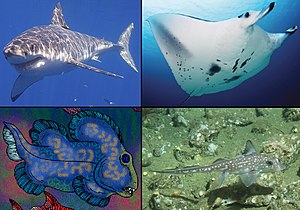Library:Overfishing drives over one-third of all sharks and rays toward a global extinction crisis (research)

Overfishing drives over one-third of all sharks and rays toward a global extinction crisis is a study published in Current Biology that highlights a significant threat to chondrichthyan fish species, including sharks, rays, and chimeras. The research, led by a team of scientists including Nicholas K. Dulvy and Colin A. Simpfendorfer, presents the first global reassessment of 1,199 species in Class Chondrichthyes.
The study reveals that over one-third (32.6%) of chondrichthyan species are now threatened with extinction, representing an alarming increase from the 2014 assessment's 24%. The threat extends to 391 species, with 180 classified as Vulnerable, 121 as Endangered, and 90 as Critically Endangered.
Three species, not sighted in over 80 years, are now classified as Critically Endangered (Possibly Extinct), highlighting the severity of the situation. The depletion of these species is primarily attributed to the ongoing demand for human food, signaling a potential crisis in global marine biodiversity.
The threat is universal across all 391 species, with overfishing identified as the sole threat for 67.3% of species. The remaining third face additional threats, including loss and degradation of habitat (31.2%), climate change (10.2%), and pollution (6.9%). The impact of overfishing is particularly pronounced in tropical and subtropical coastal waters.
The study emphasizes the urgent need for science-based limits on fishing, effective marine protected areas, and strategies to reduce or eliminate fishing mortality. Immediate action is crucial to prevent further extinctions and safeguard the vital ecosystem functions and services provided by these iconic marine predators.
As human activities continue to impact the ocean, the study underscores the importance of addressing the factors contributing to marine biodiversity loss and calls for a concerted global effort to protect these essential species. Title: Overfishing Drives Likely Global Extinctions of Chondrichthyans, New Study Reveals
A comprehensive study on the status of chondrichthyans, which include sharks and rays, highlights the alarming threat of overfishing, leading to probable global extinctions. The research, analyzing 1,093 species, reveals that 99.6% of these species are under threat, primarily due to unintentional catch, with large-scale fisheries playing a significant role. The study identifies three species as Critically Endangered (Possibly Extinct), attributing their decline to overfishing in the northern Indian Ocean. Additionally, the study underscores the impact of habitat loss, climate change, and pollution, which compound the threats faced by these marine species.
Key Findings
- Overfishing: Almost all chondrichthyans are at risk due to unintentional catch, with 67.3% facing overfishing as the sole threat. Large-scale fisheries, often combined with small-scale operations, contribute significantly to the threat.
- Extinction Risk: Three species - the Lost Shark, Java Stingaree, and Pondicherry Shark - are likely extinct, while eight others face local extinction. The study emphasizes the urgent need for directed surveys to confirm extinction status.
- Contributing Factors: Overfishing is compounded by habitat loss, climate change, and pollution. Habitat loss, in the form of residential and commercial development, agriculture, and aquaculture operations, affects 18.7% of threatened species. Climate change poses a threat to 10.2%, impacting coral reef-associated species and temperate species facing declining habitats.
- Utilization and Trade: Overfished species, often fully utilized, are primarily used for human consumption (96.6%). Some are also retained for animal feed, apparel, liver oil extraction, and purposes like aquariums and scientific research.
- Threatened Species Traits: Larger-bodied species and those with shallower median depths are more likely to be threatened. Geographic range has limited explanatory power, with rays exhibiting a higher risk in larger geographic ranges.
- Global Patterns: Threatened species closely track species richness, with disproportionately high threat levels in the tropics and subtropics. Coastal shelf waters, especially in Southeast Asia and the Indo-Pacific, face significant threats due to intensive chondrichthyan fisheries.
See also
- Animal:Shark Portal
- Category:Shark (interviews)
- Category:Shark (news)
- Category:Shark (reports)
- Category:Shark (research)
- Category:Shark finning (research)
